For many marketers, paid media is seen as a direct channel between their brands and the customer. Get your targeting, creative and budget on point, and you can instantly get your message in front of an audience eager to buy from you.
According to eMarketer, digital ad spend is expected to reach over $375 billion by 2021. This ever-growing competitive landscape, along with the fact that over 25% of U.S. consumers use an ad blocker, means profitable advertising is harder than ever.
So, how do you overcome these hurdles? What’s the most effective way to engage with your audience while maintaining a positive ROI?
For many brands, native advertising is an attractive answer to this question. It provides content that consumers are hungry for, while providing marketers a platform to quickly reach their ideal customers.
In this guide, you’ll learn what exactly native advertising is, and how to implement it as part of your paid media strategy. We’ll also share some examples for you to take inspiration from for your own campaigns.
What is Native Advertising?
Native advertising is a form of paid media that reproduces the look and feel of the platform, publication or media they appear in.
These ads appear in social media feeds, on news websites or as recommended content on a page. They blend in with the flow of content as it appears on the page you’re browsing. As a result, it provides the same experience offered by organic content on that website.
Here’s an example from Bumble, with a sponsored post on BuzzFeed around video dating:
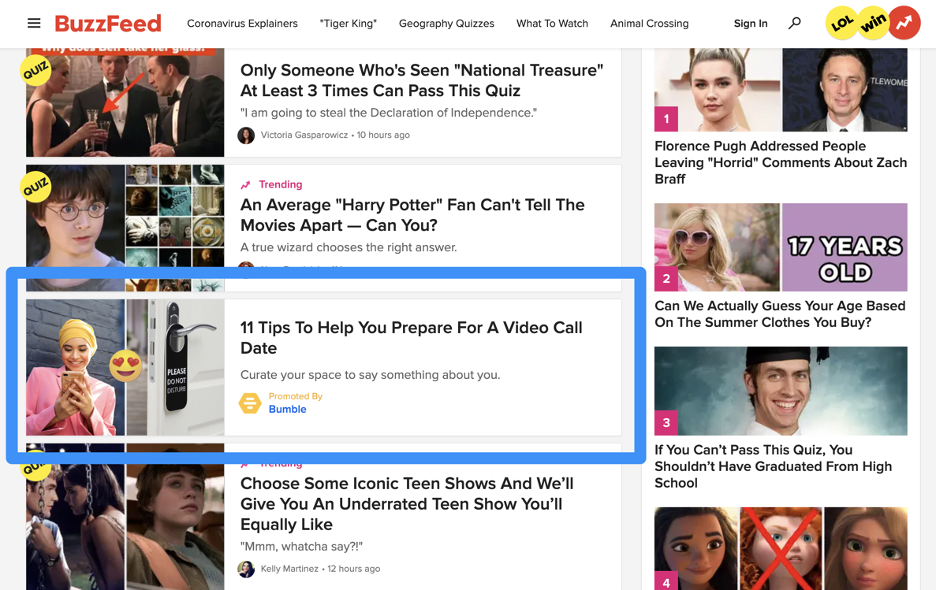
As you can see, while it is clearly labeled as a promoted post (as various advertising regulations require), it doesn’t interrupt the flow of information. Much like most “organic” articles, its purpose is to educate, entertain and engage.
While promoting ads on major publication sites is effective, native programmatic advertising allows you to go a step further and hyper-target ads on niche sites. Regardless of size, you want to promote your products and services directly to your target audience who is more likely to open and engage with your content.
There is a massive vault of native inventory that is only accessible programmatically. For example, through programmatic, you can place a native ad on the blog publishing site that a large percentage of your target audience visits daily.
Say your company recently launched a new vegan food item that you are tasked with marketing. You can place an ad for this vegan product on a health food blog that your audience subscribes to. This type of hyper-targeted marketing is incredibly effective because you’re placing your product in front of your ideal customer persona who is likely to purchase. This exciting opportunity allows you to significantly increase your ROI and grab the attention of your optimal audience.
Social media ads are also built upon a native advertising philosophy. For example, this promoted tweet from UK brand Co-op, published during the COVID-19 outbreak, blends in natively with the rest of the feed:
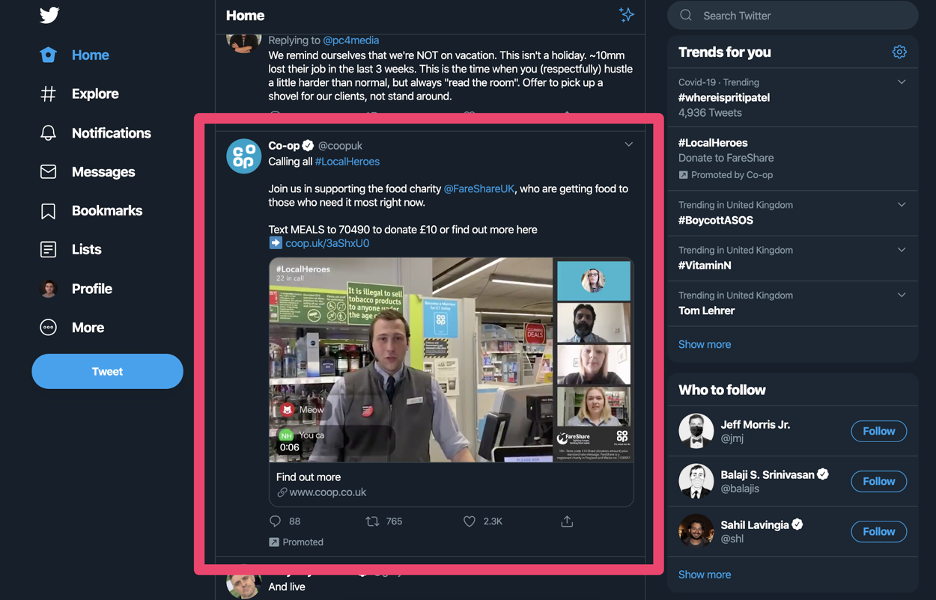
Native ads can also appear within the content you’re already engaged with. Known as content recommendations, these ads appear at the bottom of an article or page. They can drive traffic both off-site and on-site (i.e. to another page on the website you’re currently browsing).
To maintain a level of editorial transparency, publications and platforms are required to state and make clear when content is sponsored. This means users are aware and informed when they’re consuming an ad. These regulations, put in place by consumer watchdogs like the FTC (Federal Trade Commission) and the IAB (Interactive Advertising Bureau), prevent consumers from being misled.
Here’s an example of a Facebook ad where the content is clearly labelled as sponsored:
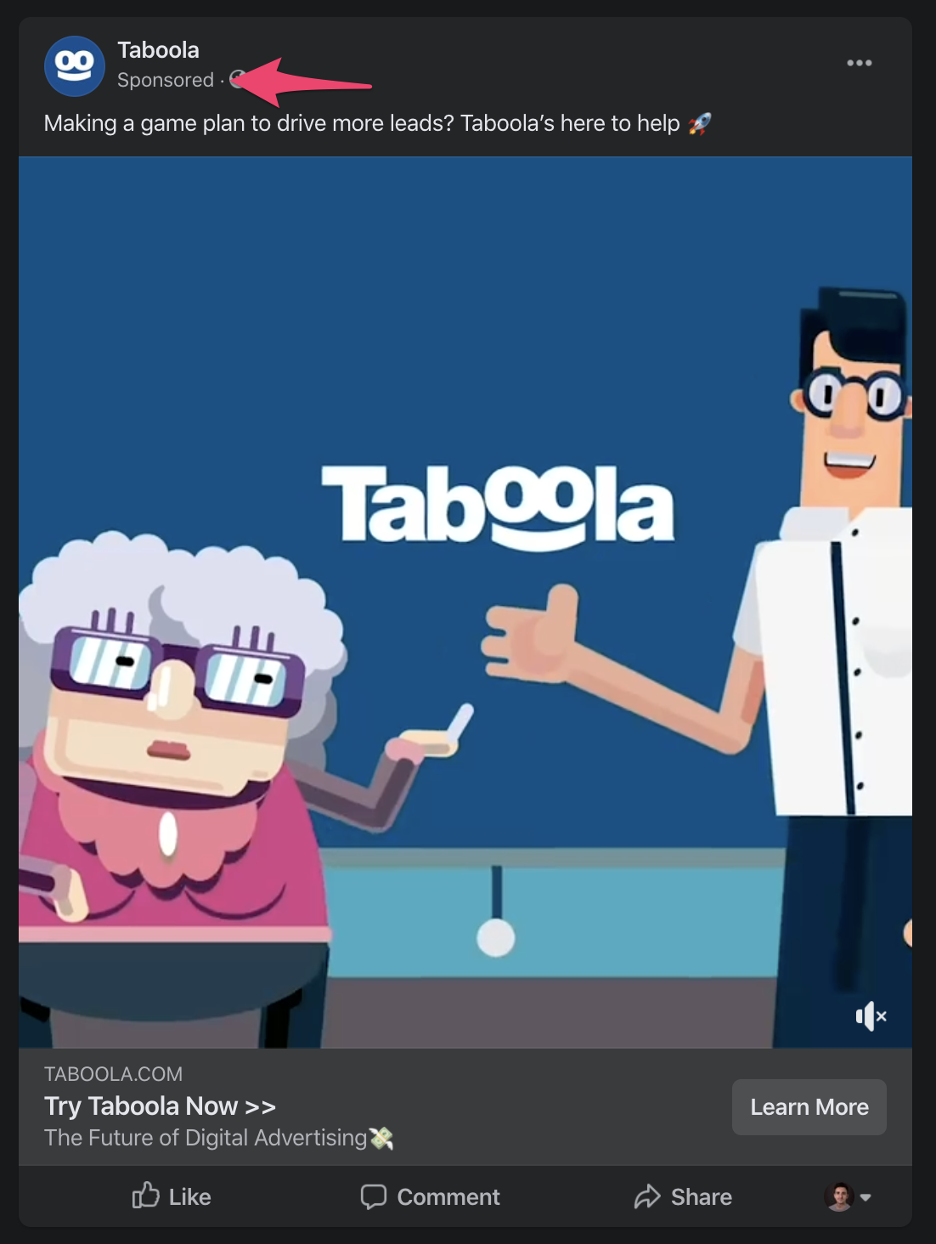
Native advertising looks great from the consumer’s perspective. But why should marketers, agencies and media buyers pay attention? Well, there are many benefits to adopting native as part of your paid media strategy:
- They’re proven to engage. According to MediaRadar, native ads generate an 8.8x increase in clicks compared to display ads.
- They build a stronger brand affinity with your customers. In fact, 71% of consumers say they identify with a brand after consuming native ad content.
- People welcome and enjoy them. According to AdWeek, generation X and Z consumers are open to brands trying new ways of engaging with them.
Now that you know what they are and why you should pay attention, let’s take a look under the hood to understand how they work.
Native Ad Networks vs. Programmatic Native Advertising
In order to truly understand how native advertising works, we need to dissect its various parts.
As discussed above, native advertising itself is the practice of blending a paid ad with the intended platform’s look, feel and function.
Programmatic advertising is a way to serve digital ads to your target audience in real-time via sophisticated algorithms, real-time bidding and access to an expansive inventory.
Native ad networks act as a middleman between publishers and advertisers as they bridge the gap between buyers with sellers. They aggregate information about what ad formats are wanted and needed across various platforms and help to push these new structures forward.
Programmatic native advertising blends programmatic advertising and native ad networks together. These platforms allow for brands or agencies to use a demand side platform (DSP) to buy impressions. On the other side, publishers use a supply side platform (SSP) to sell ad space to said brands.
This process significantly enhances the buying and selling process as it is more efficient, faster, cheaper and reliable. It allows for marketers and agencies to make native ads significantly more relevant as they are tailored to their target audience exactly where (and when) they hang out online.
How Native Advertising Works
You’ll soon learn how to implement native ads into your paid media strategy. But first, it’s important to touch upon how they work from a technical perspective.
Why? Because it will help you make the right decisions when choosing a platform, content formats and a budget to invest.
Native ads are built on three key components:
- Ad placements
- Technology
- Advertiser
Let’s explore each three in more depth:
1. Publishers and Ad Placements
Where the ad gets placed is often determined by the publisher. For example, if you wanted to advertise native content on Forbes, it would likely be placed within the news feed on the home page (or a relevant topic category page).
Social platforms like Facebook Ads allow you to select the format and placement. For example, you can advertise in the news feed, stories or in Messenger:
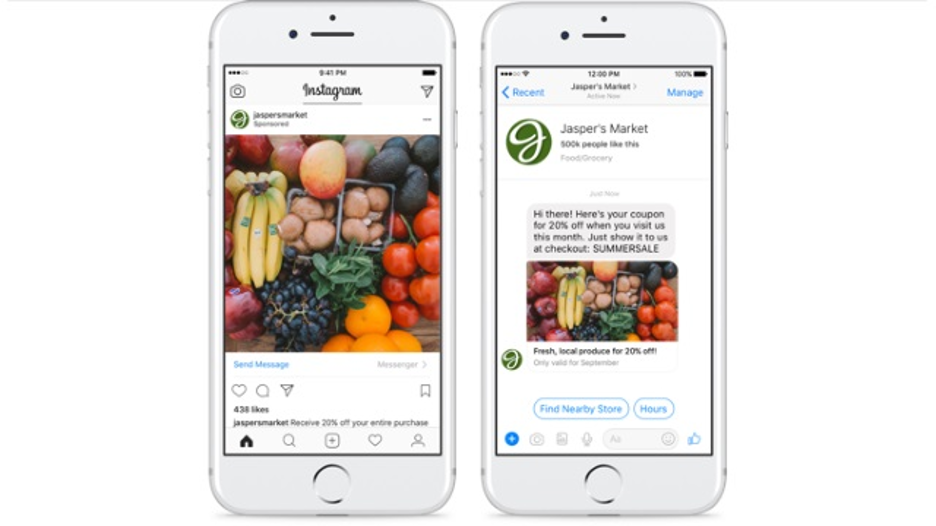
Remember, the beauty of native ads is how they blend with the feed a user is viewing. Make sure your ad creative matches the context of the platform you’re advertising on.
2. Technology
While social platforms operate with their own advertising technology, many publishers use third-party technologies to offer a native advertising service. This technology often comes in two forms:
- Ad Servers: Where the publisher works directly with advertisers (brands and agencies) to serve ads on their platform.
- Ad networks: These third-party platforms act as an exchange between the advertiser and the publisher.
As mentioned above, demand side platforms (DSPs) are the technology system that allows advertisers to buy digital inventory and impressions in order to place their target ads in the right place at the right time.
Learn more about the technology behind ad platforms and networks in our complete guide to programmatic advertising here.
3. Advertiser
This is the brand or agency working on behalf of the brand. As an advertiser, it’s your responsibility to produce and organize ad messaging, images, articles, videos and other creative.
A robust native advertising approach involves dealing with several ad networks at once. Why? Because publishers use an array of different ad networks.
But gaining access to multiple DSPs and ad networks is time-consuming and expensive. On top of that, it is next to impossible to properly leverage those technologies without a full-time subject matter expert on your team. This is why many ad buyers and brands prefer to use a trading desk to manage several networks. In turn, this expands access to premium publishers and targeting capabilities.
How to Implement Native Advertising in Your Paid Media Strategy
Now you know how native advertising works, and why you should implement it as part of your paid media efforts. Let’s dive deeper into how to implement it.
Here, we’ll explore how to put together a successful native advertising strategy. When going through this process, it’s important you have a clear understanding of the following elements:
- Your target audience and customer personas
- Your goals, metrics and KPIs
- The content you’ll use to engage with your audience
- The platforms and publications you’ll place your ads on
- The forms of advertising you’ll use (i.e. in-feed social, content recommendations etc.)
With that in mind, here’s a six-step approach to building a native advertising campaign.
Step 1: Define Your Native Advertising Goals
Your native ad goals should closely align with your overall paid media strategy. Now is a great time to get clear on what these are. Some common goals include:
- Lead generation
- Product sales
- Free trials or demos
- Newsletter subscribers
- Brand awareness
Native advertising can help you build a trusted brand. It gets your content in front of your audience, building relationships based on value. The more value-driven the content, the stronger the relationship.
Consider defining primary and secondary goals. If product sales are your “true north” KPI, then perhaps awareness (like brand awareness and email subscribers) should be a secondary goal.
Step 2: Get Clear on Your Ideal Audience
An added benefit of native ads is the ability to target an expanded audience outside of your existing customer base.
In other words, if you’re looking to expand in other markets, native advertising is the perfect vehicle to make that happen. As mentioned above, programmatic gives you access to a massive inventory with tons of native advertising options. Ranging from the big players to all types of large, medium and small companies, the options for expanding your reach are truly endless.
First, make sure you understand your customer personas. This includes demographic data, behavior and affinity for interests. For example, do certain customer segments make a purchase after reading your blog or engage with other forms of branded content?
Some marketers prefer to start off with broader targeting. This allows you to collect data over time, and then act on that data to more accurately define your audience. For example, by keeping interest- and affinity-based targeting to a minimum, focusing only on geo-targeting, you may be able to find an audience who are most receptive to your messaging from a broader pool of data.
This is especially important when using machine learning technology that acts on this data for you. By starting out with a larger dataset, machine learning can identify the most receptive audiences while reducing CPC over time.
Step 3: Finding Your Publishers
With a well-defined audience, it’s time to find out where they hang out online. There are two critical criteria to finding the right publishers for your native advertising efforts:
- The size of their audience
- How relevant their content is to your brand, product or service
While finding the right publishers can be time-consuming, it’s easier when using a trading desk. The expansive inventory it has access to, along with granular targeting capabilities, makes the publishing process far easier to manage:
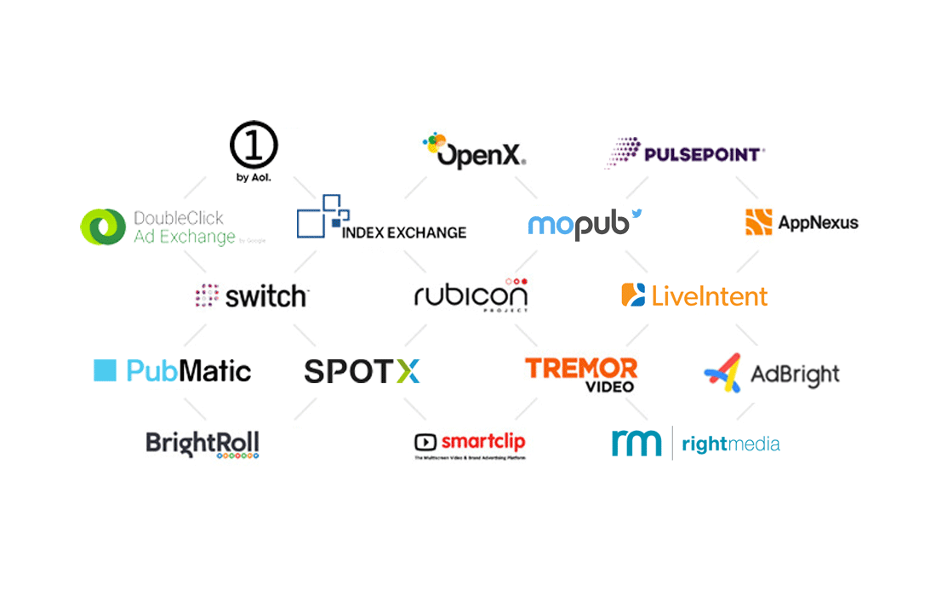
As well as the publisher itself, you must also consider the placement. This not only includes where on the publisher’s site you’ll appear, but also the user’s device and geographic location.
Step 4: Create & Collect Your Content
The content you serve your audience will largely depend on the customer lifecycle.
For example, someone researching your products or services may be interested in content that helps them make a decision. Whereas people new to your brand are likely to be more receptive to value-driven content.
Think of your native advertising as a way to satisfy user intent. To do this, the traditional marketing funnel acts as a useful model:
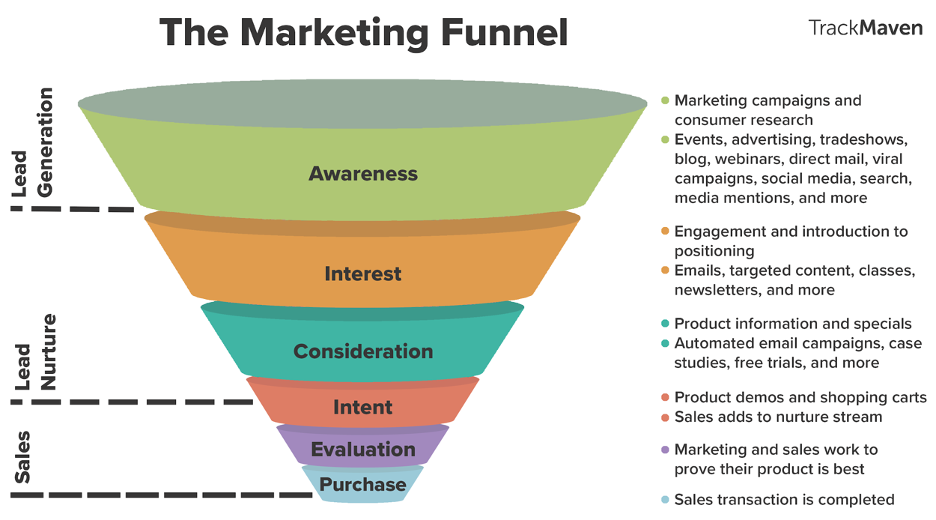
Applied to native advertising, content can be segmented along the funnel like this:
- Top-of-funnel: Useful information that helps users solve a problem or fulfill a need. This is the perfect starting point to establish a new relationship between your brand and a consumer.
- Middle-of-funnel: Drives lead generation, but is still value-driven at a foundational level.
- Bottom-of-funnel: Content that leads directly to a purchase, trial, sign-up etc.
Create content that satisfies the needs of your audience at every stage of the customer journey. Put yourself in their shoes and ask yourself what content they’re hungry for. Use native advertising as a platform to give your customers what they want.
Step 5: Engaging Ad Creative
With the content behind your ads created, it’s time to build out the creative. Depending on the publisher or platform you’re advertising on, this will include a combination of the following:
- Headline
- Description
- Thumbnail
- Call-to-action
- Video
Making these elements as engaging as possible will increase your overall clickthrough rate (CTR). Use copy that speaks directly to your audience’s pain-points, and thumbnail imagery that catches their attention as they scroll through news feeds.
Step 6: Managing & Tracking Campaigns
Once you’ve launched your ad creative and content to your desired audience, it’s time to keep on top of campaign management. This includes setting budgets and tracking results over time.
Top-notch programmatic trading desks are well-equipped to help you track your campaign beyond the main KPIs. They do this by effectively organizing and analyzing an aggregate of insights, such as customer data, CRM data, campaign data, third-party data, and more, to gain a comprehensive view of engagement.
As your audience interacts with your brand via programmatic ads, you gain invaluable, deep insights that help you glean what is and isn’t working. From there, you can further tweak your campaign to drive even more behavior-based engagement.
Start by figuring out your cost-per-click (CPC) goal. How much are you willing to spend per click? This depends on many factors, such as ticket price and margins. It’s important to know these numbers upfront.
If you’re starting your paid media efforts from scratch, you may not know what this is just yet. You’ll need to collect data over time as certain algorithms and audiences respond to your ad creative.
However, once you have enough data to make these decisions, you can then optimize your campaigns to reduce overall CPC.
Keep a regular eye on your numbers. How many people are you reaching, and what percentage of them are engaging with your ads? Most importantly, always be tracking your return on ad spend (ROAS).
While managing different publishers and ad campaigns can be time-consuming, using a platform with machine learning capabilities can alleviate much of the busywork.
For example, bid management features can automatically distribute your budget towards higher performing campaigns. As you can see below, this leads to more clicks at a lower CPC over time:
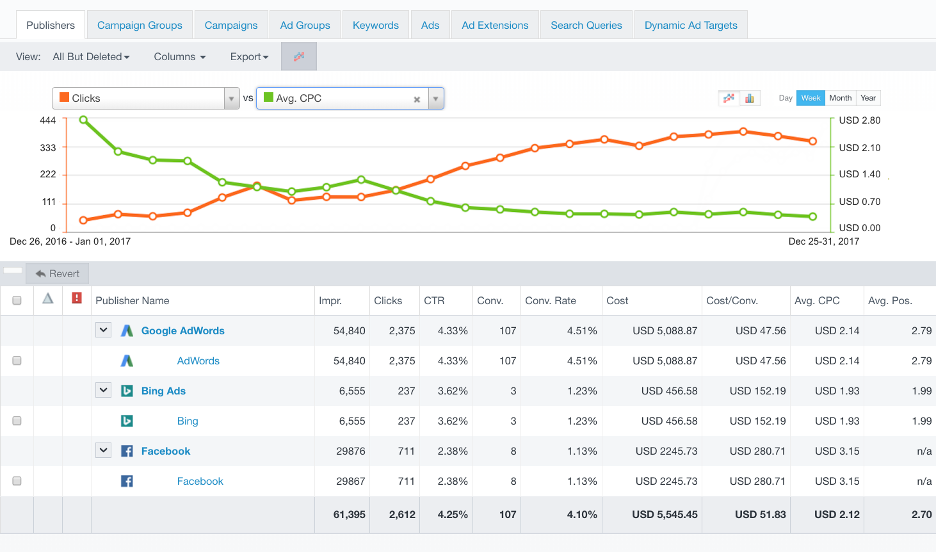
By getting smart with your campaign management processes, you can focus on high-impact and strategic activities – such as customer research and new ad creative.
5 Native Advertising Examples from Effective Campaigns
The process above acts as a flywheel. As you collect data over time, you can make more strategic decisions to inform your targeting, content and creative.
While it’s great to understand the process, it’s even better to see it in action. Which is why we’ve collected five examples of brands who have nailed their native advertising campaigns.
Example #1: Adobe in The New York Times
This first example is a poster child for what true native advertising looks like. As you can see below, this editorial-style native ad on The New York times serves to add value before all else:
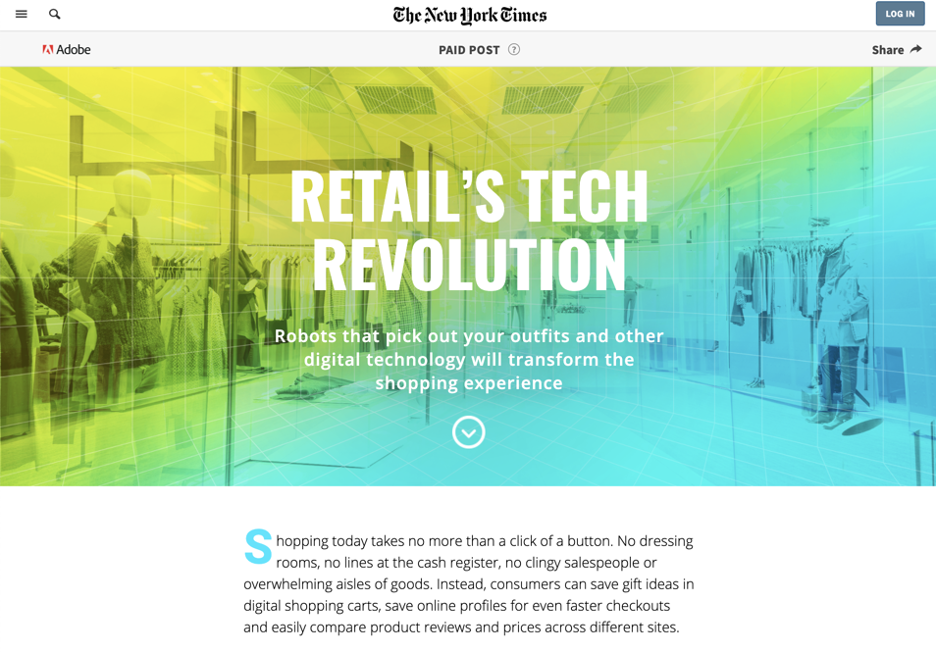
Written and targeted towards retailers, this article does several things well:
- It uses proprietary data to make compelling arguments and deliver fresh insights
- It includes real-world examples from other leading retailers
- It’s wrapped in a beautifully designed reading experience
Not only does it add value, it provides a compelling call-to-action aimed towards potential buyers for their enterprise offering:
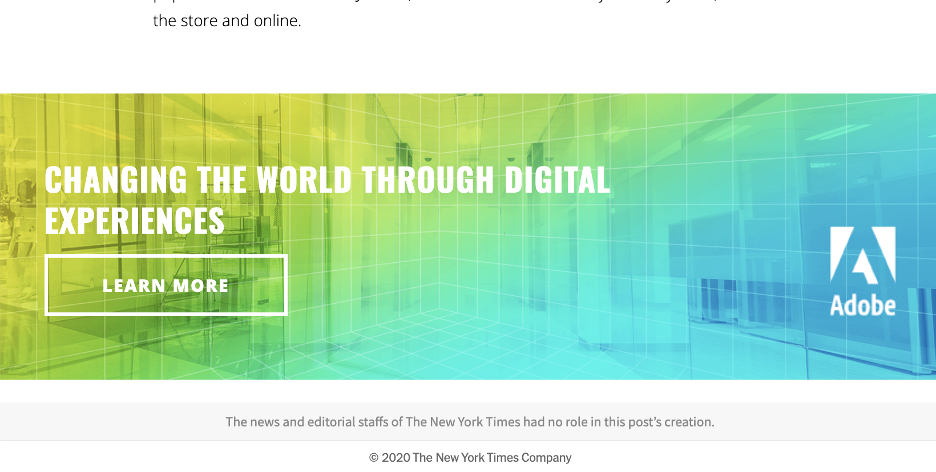
What can you learn from this? Focus on creating great editorial experiences for your target audience. Add as much value as possible, and use data and examples to make a compelling case for your products or services.
It’s important to note that it’s difficult to buy ad space on a site like the NYTimes. To do so requires access to private marketplaces (PMPs) in programmatic display. And to connect with a PMP, you need to have a phenomenal trading desk at your service.
Example #2: Taco Bell’s Snapchat Filter
If you’ve spent time on social media stories, you’ll be more than familiar with the various filters they offer.
With such popularity, it makes sense that this feature acts as prime real estate for native advertising. Which is exactly what Taco Bell did when they partnered with Snapchat to create a branded lens:
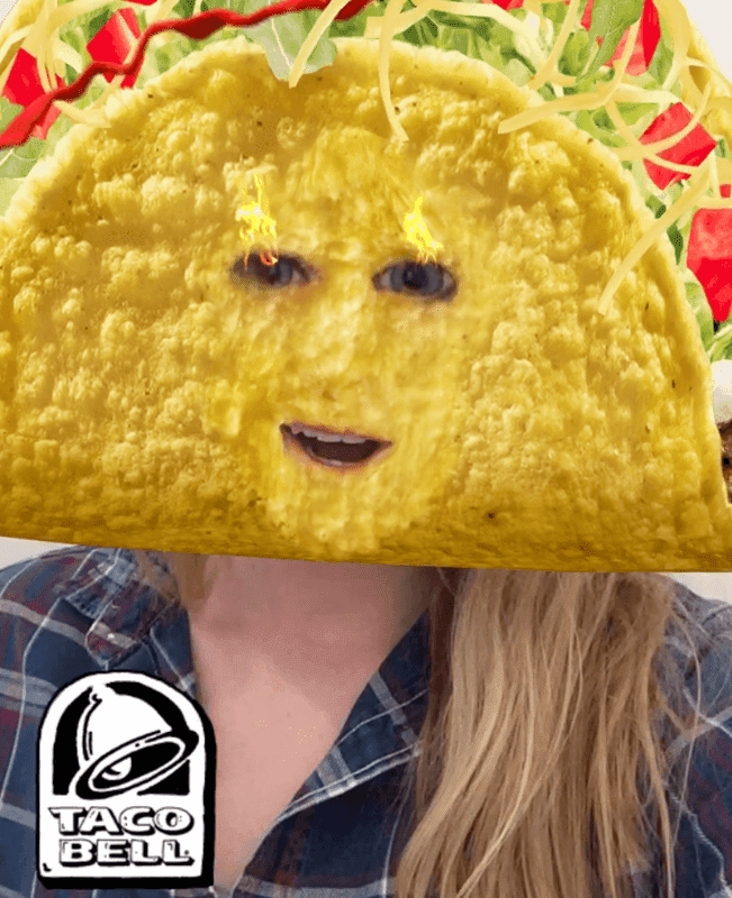
According to Adweek, the lens was viewed 224 million times by Snapchat users in a single day. This brand building campaign took advantage of a popular feature in creative and engaging ways.
What can you learn from this? New features are often popular when they’re first launched, as platforms invest a lot of budget into promoting it. Capitalize on this attention and create contextual content that engages users as they explore the feature.
Example #3: H&M’s Influencer Campaign
Within every social ecosystem = are users who have a large following. These influencers build their audiences around a specific topic or content format.
With access to a loyal fan base, they also make great partners for getting your message out to a wider audience – known as influencer marketing. This is exactly what H&M did as part of their fall studio collection campaign:
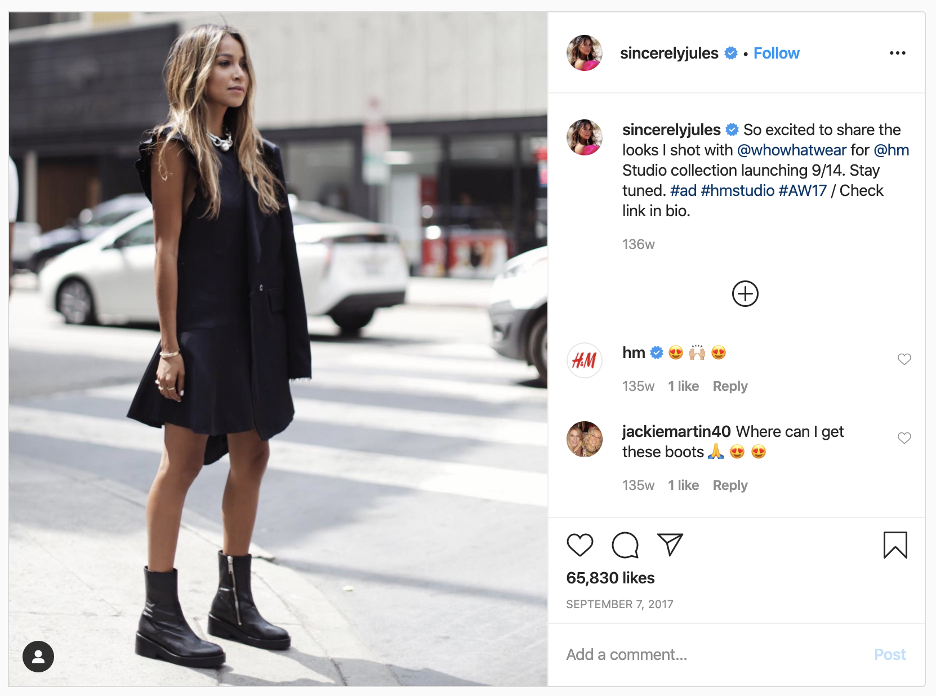
instagram-sponsored-content.png
In the example above, Julie Sariñana uses high-quality content that features H&M’s product. With access to over 5.5 million followers, this post generated over 65,000 likes and hundreds of comments.
What can you learn from this? Find out where your ideal customers are. Partner with the movers-and-shakers on those platforms to tap into their existing network. Do this with engaging, high-quality and relevant native ad content.
Example #4: Home Depot’s Collaboration with Apartment Therapy
Video content is a great format to deliver your message. When done well, it can help you connect with your customers in a personal and direct way.
In this example, Home Depot partnered with Apartment Therapy to create an interactive experience:
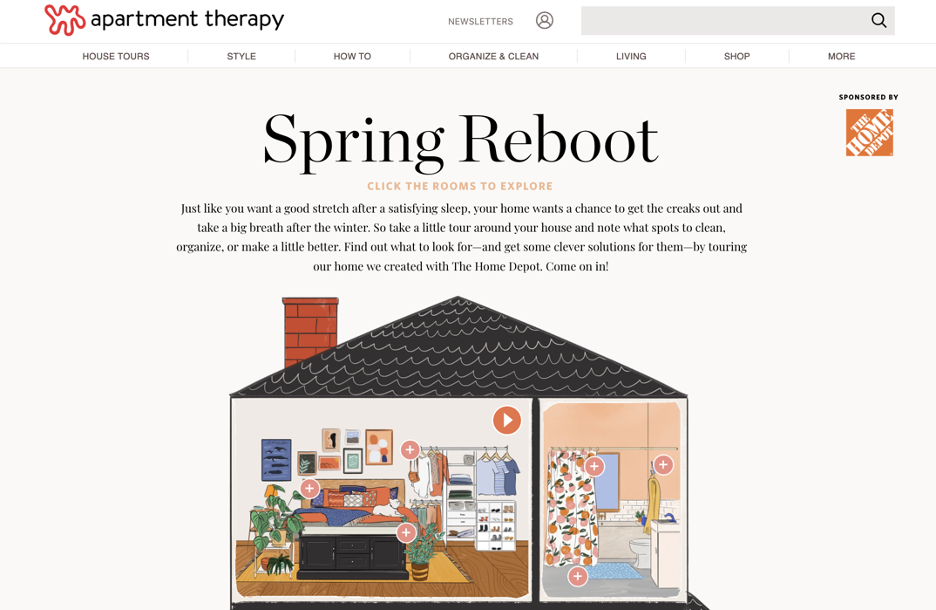
Each room included links to the relevant product, along with video content that demonstrated how they can be personalized as part of the viewers home decor:
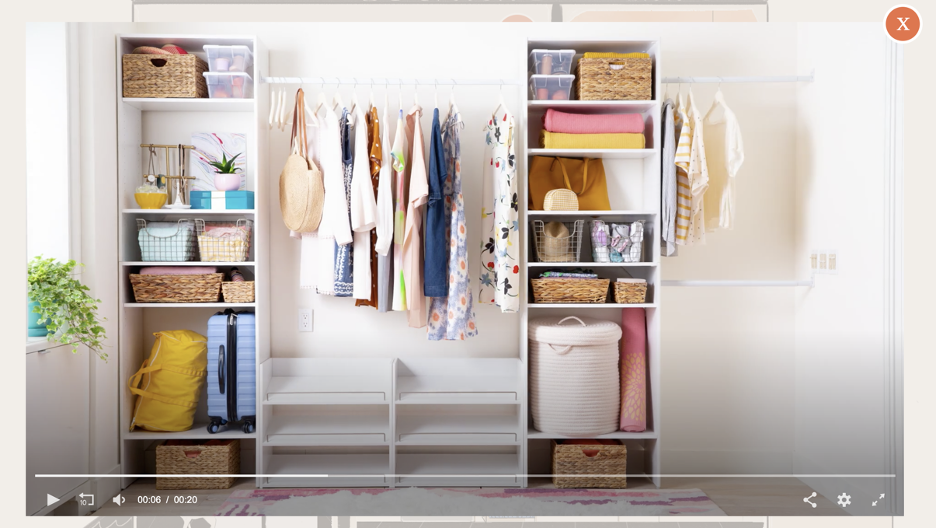
What can you learn from this? Use video to showcase your products and add an element of personalization. Home Depot partnered with Apartment Therapy because the content they offer is relevant to their brand. Find publishers that align with what you offer, creating content that provides bottom-of-the-funnel experiences.
Example #5: Harry’s Facebook Ad
Sometimes, native advertising must work with the restrictions within the ecosystem they’re placed in. The best way to get attention? Focus on what’s proven to engage with users.
Harry’s does this extremely well in their ad copy. As you can see, the use of emojis helps to break up the text and draw the user’s attention. They add personality to the copy, and is done is in a tasteful and contextual way:
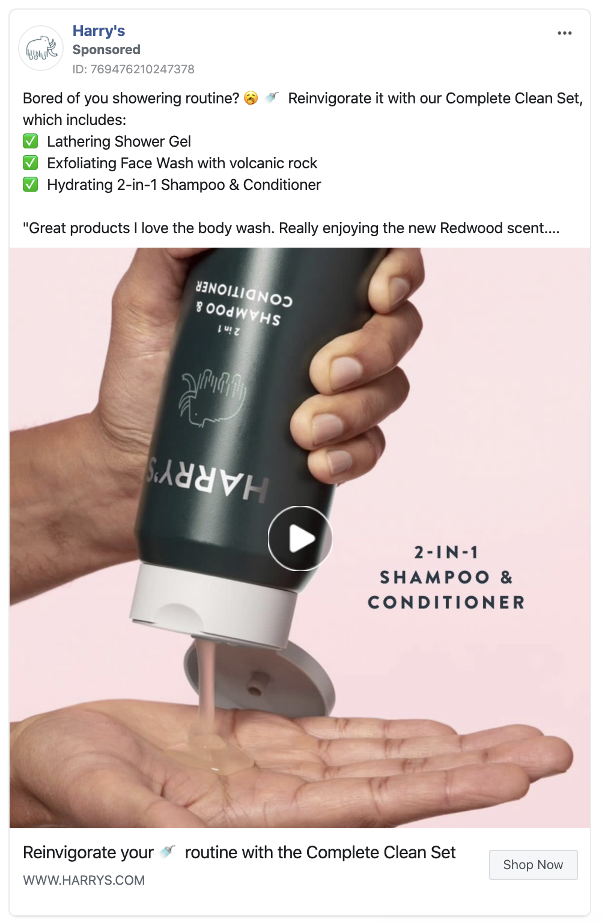
What can you learn from this? Limitation breeds creativity. With Facebook Ads, for example, you’re often limited to the elements you’re given. Make the most of this visual real estate in creative ways, using language and creative assets that resonate with your audience.
Conclusion
Your customers are hungry for value. People will remember the brands that solve a problem or fulfils a need with engaging content.
Applying these values to your paid media efforts provides a new channel to reach your audience. Through native advertising, content is packaged within the news feeds your customers are already engaging with.
To build an effective strategy, start with your audience. Figure out their needs and build out your content and ad creative from there. Scale your native ad efforts using the right tools and technology, and you’ll quickly attract new customers.
Images
Featured image: via Unsplash / True Agency
Image 1: via BuzzFeed
Image 2: via Twitter
Image 3: via Facebook
Image 4: via Adweek
Image 5 and 7: via Acquisio
Image 6: via TrackMaven
Image 7 and 8: via The New York Times
Image 9: via Adweek
Image 10: via Instagram
Image 11: Apartment Therapy
Image 12: via Facebook
